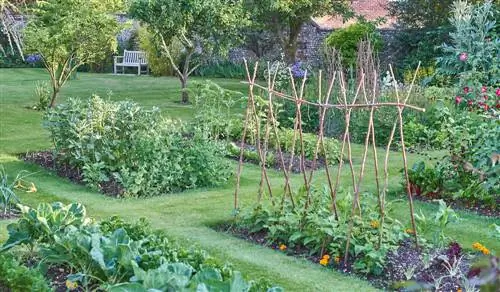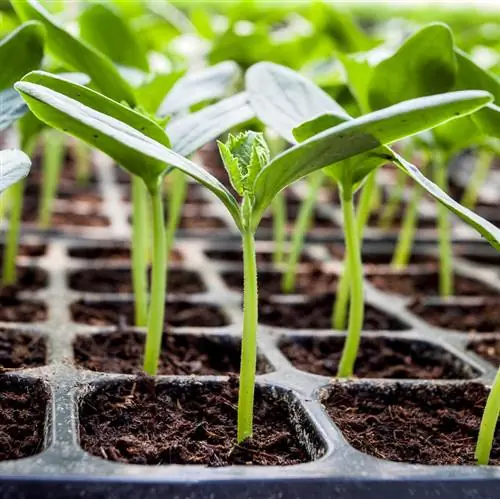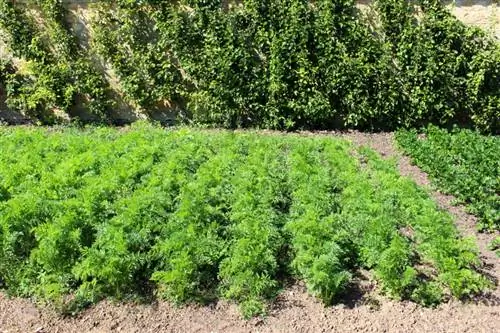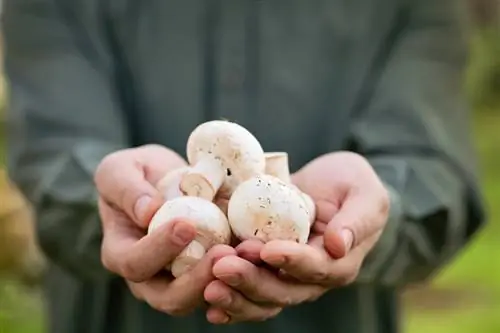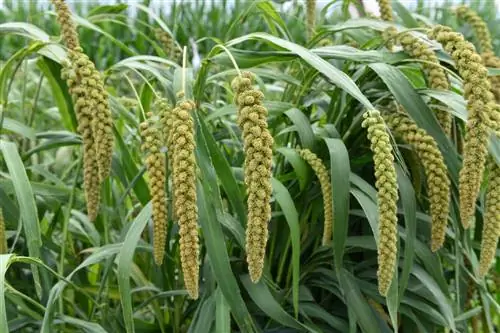- Author admin [email protected].
- Public 2023-12-26 14:17.
- Last modified 2025-01-23 11:22.
Fresh vegetables from your own garden not only taste better, but also have many other advantages: They don't have to be carted in from far away regions, you know what's "in them" (in any case there are no pesticides) and Gardening also keeps you fit. Read here how you can grow your own vegetables.
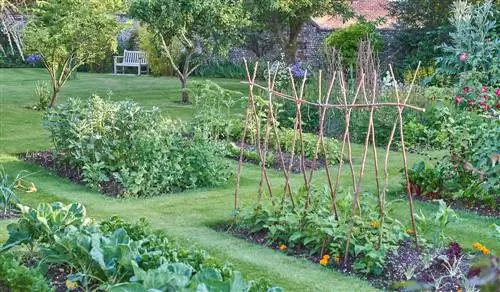
How do I grow vegetables successfully?
To grow vegetables successfully, choose uncomplicated varieties such as beans, garlic, kohlrabi, herbs, chard or radishes. Pay attention to the correct sowing time, crop rotation and mixed culture. Good care includes regular watering, fertilizing and weeding.
These vegetables are particularly uncomplicated
If you don't have much experience growing vegetables, it's best to use these uncomplicated types of vegetables:
- Beans: Bush beans in particular don't need much care and produce rich yields. Just sow them after the Ice Saints. Since this type of bean only grows to a height of 40 to 50 centimeters, supporting structures are also not necessary.
- Garlic: If you like garlic, simply stick a few cloves (with the tip up!) into the bed in spring or autumn. The plant then grows almost on its own. By the way, garlic and strawberries go well together because the tubers keep many pests away from the strawberry plants.
- Kohlrabi: Kohlrabi is also incredibly simple: the young plants go into the vegetable patch and grow there until the tubers are thick enough to harvest.
- Herbs: Herbs such as chives, parsley etc. should not be missing in any garden. They are indispensable in the kitchen and generally very uncomplicated in culture.
- Chard: Chard is also unknown to many people, but it is very easy to grow, tasty and he althy. The colorful stems can be harvested eight to ten weeks after sowing and continue to grow back.
- Radishes: You can sow radishes almost all year round and harvest them after just four weeks.
- Beetroot: Beetroot is also wonderfully easy to cultivate, and you can also leave the tubers in the ground in winter and simply harvest them as needed. To do this, cover the bed with a protective layer of straw.
- Salad: Whether cut or picked: almost all types of lettuce are fast-growing and uncomplicated. The plants should be fertilized little, but need soil that is always slightly moist.
- Jerusalem artichoke: The he althy tubers of this type of sunflower are still little known in this country, but are a delicious vegetable that can be prepared in many ways. In addition, the large flowers of the plants, which are up to three meters high, decorate any garden. But be careful: be sure to install a root barrier, as Jerusalem artichoke tends to overgrow.
- Zucchini: Zucchini plants grow huge and need a lot of space. Provided with enough water and in a sunny and warm location, a family of four can be supplied with delicious fruits all summer long with just one or two plants.
- Onions: Onions are just as uncomplicated as garlic: just buy onion sets and stick them in the ground. The plants practically grow by themselves.
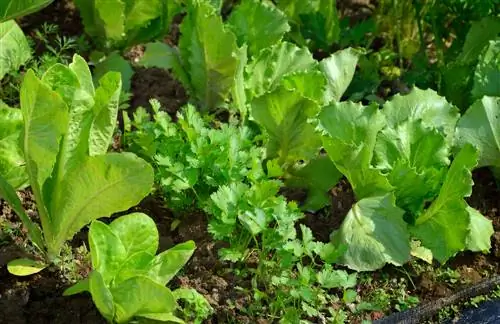
Herbs and lettuce are particularly easy to grow
The vegetables listed are particularly robust and can easily forgive one or two mistakes. Nevertheless, you can hope for a rich harvest as long as the summer is not too cold and rainy. If you garden together with your (small) children, it is best for the little ones to have their own vegetable patch so that they can do as they please. Prefer fast-growing vegetables that are great to eat straight from the bed: radishes or sugar peas, for example, are ideal.
When can which vegetables go into the bed?
After you have decided which vegetables should go into the vegetable garden, it is now time to prepare the soil. Loosen the garden soil well and as deeply as possible so that the plants can later root deeply. It is best to carry out work such as digging in the autumn so that the ground remains fallow over the winter and the frost can refine the thick earth crumbs. Before digging, you can also sow green manure (e.g. Phacelia), let it emerge and then dig it up later.
Sowing calendar
Of course, you traditionally cultivate your vegetable garden in spring. However, not all types of vegetables can be planted in the bed at the same time, because some cannot tolerate frost and should therefore be planted out as late as possible. Others, however, can also be grown later in the year - for example as a so-called subsequent crop - so that the vegetable beds are used to the best possible extent from spring to autumn. The following overview shows you when you can sow the most popular vegetables.
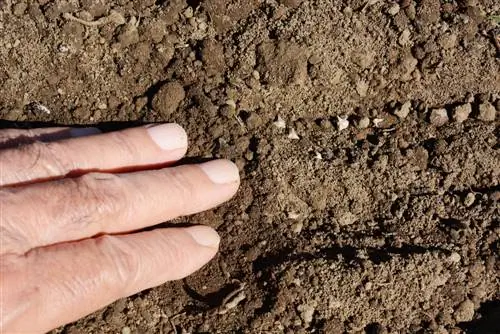
Spinach can be sown at the end of March
| Sowing | Vegetables |
|---|---|
| March / April | Spinach, radishes (early varieties), cauliflower (early varieties), parsnips, onions, lettuce, carrots, kohlrabi |
| May / June | Bush beans, cucumbers, zucchini, radishes (following seeds), lettuce (following seeds), peas, pumpkin, chard, broccoli, cauliflower (late varieties), kale, Brussels sprouts, turnips |
| July / August | Spinach (autumn varieties), radishes (sowing), lamb's lettuce, leek |
| September | Spinach, chard, rocket, lamb's lettuce, winter garlic, winter garlic |
If you sow in September, you won't harvest the resulting vegetables until the following March. The exception here is the late-sown rocket, which you can harvest from October. Otherwise, you can sow the vegetables mentioned directly into the bed or plant them as young plants. With the latter option you will harvest faster.
Excursus
Which vegetables should you prefer?
In particular, you should plant frost-sensitive vegetables such as tomatoes, peppers, zucchini, cucumbers or chili on the windowsill from February / March and only plant them in the garden or greenhouse from around mid to late May. Bringing forward is also important here because the late planting date would otherwise not allow for a timely harvest before winter.
Observe crop rotation
“Proper crop rotation prevents many diseases caused by weakness.”
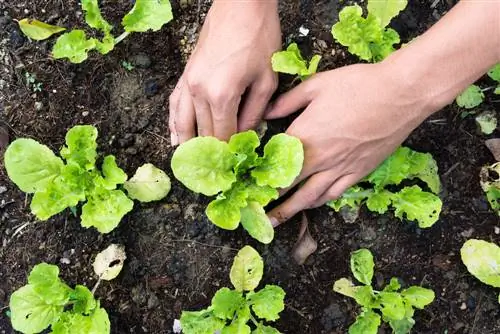
Lettuce is often grown as a pre-crop
Vegetable beds need to be used carefully and should leave as little waste as possible. For this reason, you don't just grow a single type of vegetable on a bed, but combine so-called main crops with previous and subsequent crops. Main crops are species that have a long growing time and therefore require a lot of time in the bed. These species are usually not planted in the bed until May/June, which is why fast-growing pre-cultures are recommended. After the harvest, however, you grow additional crops.
For staggered cultivation planning, if possible, choose plants from different plant families and with different nutrient requirements. For example, a heavy feeder should not be cultivated after a heavy feeder - i.e. a plant with a high nutrient requirement should be cultivated after another - but rather a species with a lower requirement should be followed. The following overviews will help you choose suitable combinations.
Table 1: Primary, main and secondary crops
| Culture form | Suitable vegetables |
|---|---|
| Pre-culture | Lettuce, spinach, radishes, pickled and Asian salads, rocket, spring onions, May turnips, early onions, kohlrabi |
| Main Culture | Tomatoes, peppers, potatoes, sweet corn, cucumbers, zucchini, carrots, various types of cabbage, pumpkin, eggplant |
| Postculture | Spinach, radishes, bush beans, lamb's lettuce, leek, kohlrabi, rocket |
Table 2: Plant families

The eggplant belongs to the nightshade family
When rotating crops, make sure not to let vegetables from the same plant family follow each other. Proven combinations include spinach before carrots, bush beans after potatoes or lamb's lettuce after cabbage.
| Plant family | Related vegetable plants |
|---|---|
| Umbelliferous plants | Fennel, carrots, parsley, celery |
| Goosefoot family | Swiss chard, beetroot, spinach |
| Asteraceae | Artichokes, salads, salsify |
| Cruciferous vegetables | Radish, radish, rocket, all types of cabbage |
| Pumpkins | Cucumbers, pumpkin, melon, zucchini |
| Lilies | Leeks, garlic, onions |
| Solanaceae | Aubergines, potatoes, peppers, tomatoes |
| Butterflies | Beans, peas |
Nutrient requirements of plants
Before planting or sowing heavy-feeding vegetable plants - i.e. those with a high nutrient requirement - the vegetable bed should be supplied with organic fertilizers. Compost and horn shavings are suitable here, but also rotted stable manure. However, salads and leafy vegetables in particular may only be lightly fertilized, otherwise too many harmful nitrates will accumulate in the leaves.
| Nutrient requirements | Vegetable plants |
|---|---|
| Weak eater | Bush beans, peas, lamb's lettuce, lettuce, almost all herbs |
| Middle eaters | Aubergines, fennel, kohlrabi, chard, carrots, peppers, radishes, beetroot, salads, spinach, runner beans, onions |
| Heavy eaters | Cucumbers, potatoes, cabbage, pumpkin, leeks, New Zealand spinach, celery, tomatoes, zucchini, sweet corn |
For he althier plants: mixed culture
In this video you will get lots of great and tried-and-tested tips to imitate in your own garden:
video: Youtube

Mixed culture means that you don't just grow one type of vegetable on the bed, but different ones. This mix keeps the plants strong and he althy, making it easier for them to defend themselves against diseases and pests. As a result, you need fewer chemical pesticides and garden completely organically. To ensure that the mixed culture is successful and that the individual plants complement each other well, these tips will help you:
- Do not cultivate plants from the same plant family together.
- Don't just plant heavy feeders in the vegetable patch, but also heavy, medium and weak feeders.
- This prevents the soil from becoming too leached.
- Plant slow-growing vegetables next to fast-growing ones, with the slower ones best placed in the middle of the bed and the fast ones at the edge.
- Place deep-rooted plants (carrots, salsify, radishes) next to shallow-rooted plants (salads and other leafy vegetables, herbs).
- Plant herbs in the bed or use them as a border.
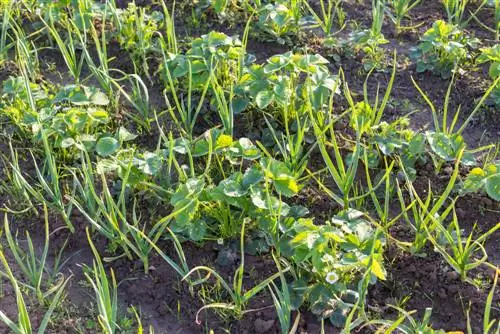
Garlic and strawberries are a true dream couple
We have summarized for you which herbs go particularly well with which vegetables in the following table:
| Herbs | Good vegetable neighbors |
|---|---|
| Basil | Cucumber, tomato, onion |
| Dill | Beans, cucumber, all types of cabbage, carrots, tomatoes, potatoes, onions |
| Nasturtium | Potatoes, runner beans, tomatoes |
| garlic | Strawberries and other berries, cucumbers, carrots, salads, tomatoes |
| Garden cress | Lettuce, radishes |
| Lavender | Potatoes, all types of cabbage |
| parsley | Leeks, radishes, tomatoes |
| Marigold | Peas, nightshades such as potatoes and tomatoes |
| Rosemary | Beans, cabbage, carrots, tomatoes |
| Sage | Cabbage, carrots, tomatoes |
| Chives | Cabbage, leek, carrots, tomatoes |
| Tagetes (student flower) | Potatoes, tomatoes |
Excursus
How to keep snails out of vegetable beds
Snails love to attack many vegetable plants and herbs, which is why you should plan the beds with good snail protection right from the start. To do this, surround the beds with a snail fence before planting or mulch the areas with straw or shredded bark. The latter also has the advantage that the mulch retains moisture in the soil and it does not dry out so quickly. Particularly sought-after snail food is best grown in raised beds.
Care for vegetables properly
So that the vegetable plants grow well and you can reap a rich harvest, you should take good care of the beds. A vegetable garden is a lot of work, but it also keeps you fit and rewards you. Pay particular attention to these instructions:
- Watering: Vegetable plants need a lot of water, especially when the fruit is ripening, and should under no circumstances be subject to drought stress. Water the vegetable patch preferably in the morning, vigorously and penetratingly. On particularly hot days, treat your plants again in the early evening. However, never pour over the leaves, always directly onto the ground!
- Fertilizing: The vegetable patch should be supplied with compost and rotted manure in the fall of the previous year so that the nutrients are absorbed into the soil and the humus content increases. Plants with a medium to high nutrient requirement should also be supplied with organic fertilizers during the growing season. Apply compost and horn shavings for this purpose, preferably when planting and again in June/July.
- Weeding: Regular weeding is essential so that vegetables can grow and do not have to compete with other plants for light and nutrients. Unfortunately there is no way around it. However, suitable tools (e.g. a weed hoe (€23.00 on Amazon) with a long handle) will make your work easier. Take this opportunity to loosen the soil regularly so that water can penetrate better and the surface does not harden.
- Mulching: Mulching the vegetable bed not only helps to retain moisture in the soil for longer and suppresses weeds. Suitable materials - such as green waste - are also ideal as additional fertilizer and rot quickly.
Frequently asked questions
Which vegetables store particularly well?
Most vegetables should be prepared or preserved fresh or within three days at the latest. Potatoes, pumpkins, some root vegetables such as carrots, parsnips, beetroot, radishes, salsify, onions and garlic can be stored for a long time. However, the prerequisite for a long shelf life is storage in a dark, cool and dry place. In addition, the stored vegetables should be free of all leaves and the peel should be intact.
What is the best way to preserve vegetables?
Leafy vegetables in particular should be cleaned immediately after harvesting, blanched briefly and then frozen. Actually, almost all types of vegetables - cut into bite-sized pieces - can be frozen well and will last for at least six months. Traditional cooking, on the other hand, is a little more complex to produce, but has a longer shelf life and is also more resource-efficient. Preserve.
Are there any vegetables you can grow in winter?
Typical winter vegetables that can withstand even sub-zero temperatures include lamb's lettuce, beetroot, parsnips, Brussels sprouts, white cabbage, kale, chicory, salsify, turnips (called "Wrucken" in Northern Germany) or the lesser-known Jerusalem artichoke.
Which vegetables can I grow on the balcony?
Basically, pretty much any vegetable can be grown on the balcony. Please note, however, that plants grown in planters require significantly more care than those grown in vegetable patches: regular watering and fertilizing is mandatory, otherwise disease will occur and the harvest will be poor. By the way, vine and bush tomatoes, cucumbers, radishes, salads, beans, sugar peas and chard work particularly well.
Tip
Do not sow or plant all the vegetables of a variety at the same time, but bring plants and seeds into the bed a few days apart. This way you don't harvest the fruits all at the same time, but one after the other.

